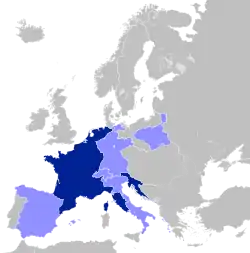Cispadane Republic
The Cispadane Republic (Italian: Repubblica Cispadana) was a short-lived client republic located in northern Italy, founded in 1796 with the protection of the French army, led by Napoleon Bonaparte. In the following year, it was merged with the Transpadane Republic (formerly the Duchy of Milan until 1796) to form the Cisalpine Republic. The Cispadane Republic was the first Italian sovereign State to adopt the Italian tricolour as its flag.[1]
Cispadane Republic | |||||||||||||
|---|---|---|---|---|---|---|---|---|---|---|---|---|---|
| 1796–1797 | |||||||||||||
 Northern Italy in 1796. Modena and Papal Legations (all lower right) were merged into the Cispadane Republic. | |||||||||||||
| Status | Client state of France | ||||||||||||
| Capital | Bologna | ||||||||||||
| Common languages | Italian | ||||||||||||
| Government | Directorial system | ||||||||||||
| Legislature | Legislative Body | ||||||||||||
| Council of Thirty | |||||||||||||
| Council of Sixty | |||||||||||||
| Historical era | Napoleonic Wars | ||||||||||||
| 10 May 1796 | |||||||||||||
| 19 February 1797 | |||||||||||||
| 29 June 1797 | |||||||||||||
| 17 October 1797 | |||||||||||||
| Currency | Bolognese lira and all other old currencies | ||||||||||||
| |||||||||||||
History

On 16 October 1796, a congress was held in Modena after the ruler, Duke Hercules III, had fled to Venice to escape the French advance.[2] The congress was formed by representatives from the provinces of Modena, Bologna, Ferrara and Reggio Emilia, all located south of the Po.
The congress was unofficially organized by Napoleon, whose French army had swept through northern Italy earlier in the year, and who needed to settle the situation in Italy and gather new troops for an offensive against Austria.[3]
The congress proclaimed that the four provinces would form the Repubblica Cispadana: a civic guard, composed of mounted hunters and artillery, was formed.[4] In the 7 January 1797 session, in Reggio Emilia, the congress decided to form a government.
The flag, the first tricolour in Italy, was a horizontal tricolour, with red (top), white and green stripes.[5] In the centre was an emblem composed of a quiver, accolade to a war trophy, with four arrows that symbolized the four provinces forming the Republic, all within a crown of bay.[3] The Cispadane Republic was the first Italian sovereign State to adopt the Italian tricolour.[1]
On 29 June 1797, the Cispadane Republic united with the Transpadane Republic to form the Cisalpine Republic.[6][7]
Citations
- Villa 2010, p. 11.
- Busico 2005, p. 209.
- Busico 2005, p. 210.
- "La Repubblica Cispadana" (in Italian).
- "I simboli della repubblica - il tricolore" (in Italian). Retrieved 22 March 2015.
- Maiorino 2002, p. 162.
- Villa 2010, pp. 13–14.
References
- Busico, Augusta (2005). Il tricolore: il simbolo la storia (in Italian). Presidenza del Consiglio dei Ministri, Dipartimento per l'informazione e l'editoria. SBN IT\ICCU\UBO\2771748.
- Maiorino, Tarquinio; Marchetti Tricamo, Giuseppe; Zagami, Andrea (2002). Il tricolore degli italiani. Storia avventurosa della nostra bandiera (in Italian). Arnoldo Mondadori Editore. ISBN 978-88-04-50946-2.
- Villa, Claudio (2010). I simboli della Repubblica: la bandiera tricolore, il canto degli italiani, l'emblema (in Italian). Comune di Vanzago. SBN IT\ICCU\LO1\1355389.


